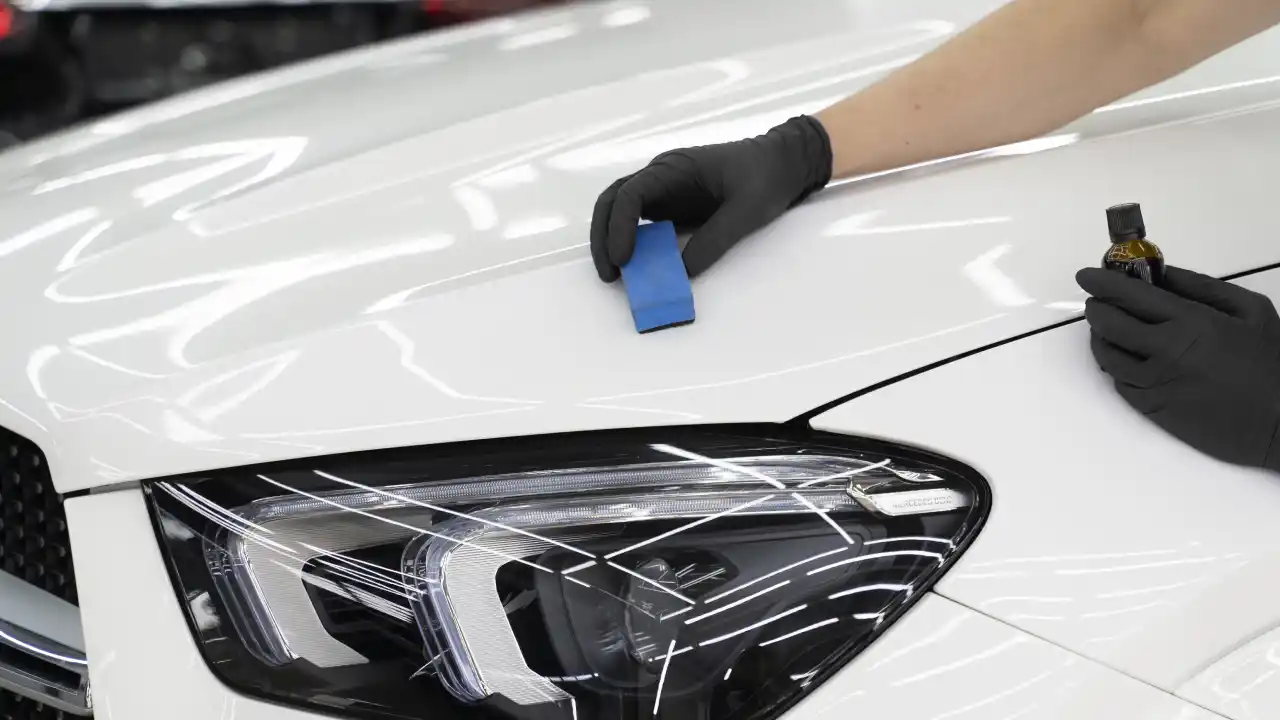Exploring the Science Behind Ceramic Finishing and Its Effect On Car Outlining
The application of ceramic covering in car outlining represents a substantial development in automotive care, rooted in its advanced chemical properties, mainly silica dioxide and titanium dioxide. Understanding the science behind these products discloses not only the safety advantages they supply however likewise their duty in enhancing a vehicle's aesthetic durability. As we check out the intricacies of the application procedure and the long-lasting implications for automobile upkeep, it ends up being clear that the selection of ceramic coating can essentially modify one's technique to cars and truck treatment. What considerations should be made before committing to this transformative remedy?
What Is Ceramic Finish?
Ceramic layer is a modern option that has actually gotten appeal in the auto describing sector for its capacity to provide resilient protection for lorry surface areas. This sophisticated safety layer is generally composed of silica dioxide (SiO2), which forms a solid bond with the lorry's paint, producing a durable shield against ecological pollutants. Unlike typical wax or sealants, ceramic coatings use remarkable resistance to UV rays, chemical discolorations, and physical abrasions.
The application of ceramic coating involves a thorough procedure, where the lorry's surface area is extensively cleaned and decontaminated prior to the finish is applied (Ceramic Coating). Once treated, the covering enhances the lorry's gloss, deepness, and quality, providing a showroom-quality coating that lasts for several years. One of the crucial advantages of ceramic coating is its hydrophobic homes, which fend off water and dirt, making maintenance much easier and minimizing the regularity of washes
The Chemistry of Ceramic Finishing
A basic aspect of ceramic covering lies in its chemical make-up, largely identified by the existence of silica dioxide (SiO2) This substance is essential to the development of a sturdy, protective layer that bonds chemically to the automobile's surface area.
In addition to SiO2, several ceramic layers integrate titanium dioxide (TiO2) and other ingredients to improve their efficiency characteristics. TiO2, for instance, adds to enhanced firmness and chemical resistance. The interaction in between these compounds produces a special molecular structure that offers a high degree of security versus environmental variables such as UV rays, acid rainfall, and oxidation.
Additionally, the application procedure often includes a meticulous preparation of the surface to make certain optimum adhesion of the covering. This chemistry not just guarantees a resilient surface yet also enhances the visual appeal of the automobile. Understanding the detailed chemistry behind ceramic finishes is important for detailing professionals that aim to give superior protection and longevity for their customers' vehicles.
Advantages of Ceramic Finishing
While outlining experts commonly highlight the benefits of ceramic coatings, their benefits prolong far beyond visual appeals. Ceramic coatings develop a hydrophobic surface that wards off grime, water, and dirt, considerably reducing the frequency of cleans and the effort required to maintain a car's appearance.
In addition, ceramic layers improve the durability of the car's coating. Unlike traditional waxes or sealers, which may last a few months, ceramic layers can sustain for many years, offering a long-term solution for automobile care. This sturdiness converts to set you back financial savings, as proprietors are less likely to require frequent reapplication.
Additionally, ceramic layers are immune to chemical spots and etching, which can occur from acidic materials like bird droppings or tree sap. This resistance not only protects the lorry's appearances but also decreases possible damage - Ceramic Coating. In general, the financial investment in ceramic finishing provides car proprietors a substantial return in regards recommended you read to security, simplicity of maintenance, and durable visual appeal, making it a significantly popular option in the realm of automobile detailing
Application Process Discussed

As soon as the surface area is appropriately prepared, the ceramic covering can be applied. Using an applicator pad, the professional uses the coating in little sections, working in a crosshatch pattern to make certain even insurance coverage.
When treated, the ceramic finish develops a strong bond with the paint, offering improved defense and a shiny coating. Proper application is essential to make best use of the durability and performance of the ceramic covering.

Long-lasting Effect On Vehicle Care
The long-lasting influence of ceramic coating on vehicle care is considerable, as it essentially modifies how owners keep their automobiles. By creating a long lasting, hydrophobic layer on the vehicle's surface area, ceramic coatings lessen the adherence of dirt, crud, and impurities. This residential property reduces the regularity of washing called for, inevitably preserving water and cleaning products.
In Addition, the UV defense used by ceramic coverings aids to protect against oxidation and fading of the vehicle's paint, protecting its aesthetic appeal and resale value in time - Ceramic Coating. This protective barrier additionally minimizes the possibility of scratches and swirl marks, which are usual issues in standard paint coatings
Moreover, ceramic coverings facilitate simpler upkeep, enabling proprietors to cleanse their lorries site web with minimal initiative. The smooth surface makes it tough for pollutants to bond, enabling less complex elimination throughout regular cleansing.
In the lengthy run, the investment in ceramic covering may lead to set you back savings in automobile treatment products and solutions. On the whole, the enduring advantages of ceramic finishings not only boost the look of lorries but additionally add to a more sustainable and efficient technique to lorry upkeep.
Verdict
Finally, the application of ceramic layer represents a considerable improvement in vehicle detailing, driven by its distinct chemical make-up of silica dioxide and titanium dioxide. This modern technology not just boosts the visual appeal of vehicles but likewise supplies durable protection versus environmental dangers and put on. The long-term advantages, consisting of reduced maintenance regularity and boosted resilience, highlight the worth of ceramic finishings as an important investment for preserving vehicle look and honesty in time.
